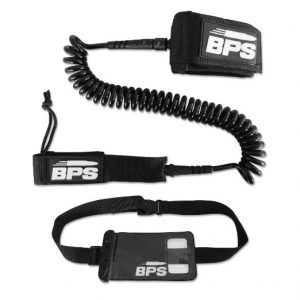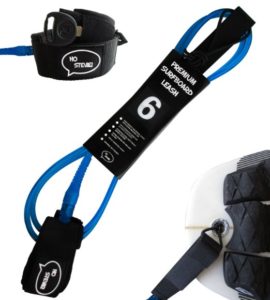Most SUPs you get – either buying your own or renting one – should come with an ankle leash, or the option to put on on. It is probably one of the most important pieces of equipment to go with your board, since it is what keeps your board with you in almost any circumstance.
The ankle leash is essential when it comes to safety while out on the water, even more than a life jacket in my opinion. This is because if you’re paddling far from shore, or the weather changes and wind pushes you out with larger waves, you NEED to stay with your board. It could save your life by just being able to stay on/with your board.
Even in a slight wind and waves, if you fall off your board far from shore, the wind could push your board out of your grasp quickly, leaving you with no flotation device.
I’m guilty myself of just going out and letting the leash drag in the water, not attached to my ankle. Now I do mostly SUP on Lake Huron (not an ocean), and only when its calm, but I do tend to go out deep and one wrong move and I could be in the water with my board floating away. Hasn’t happened yet, but waves and wind could hit at any time and having your board attached to you is important. So do it.
What Kind of Leash to Get?
There are two main types of leashes – coiled and straight. Both have their advantages and disadvantages. Coiled leashes have a better chance not dragging in the water in calm conditions, giving you less drag, but they do have a chance to get more tangled in rough water. Straight leashes do drag in the water, but are more likely to remain untangled.
The length of the leash should be just longer than the board. This way you can get all around the board while tethered to it while you’re in the water.
All leashes should have a Velcro cuff to attach to the wearer. Some are simple with a single Velcro wrap, while others have a double wrap to make it even more secure. The Velcro cuff makes the leash secure, but also allows for a fairly quick release if needed.
Depending on the type of paddleboarding you plan on doing – casual touring, river or surfing – look into reviews and write ups for the leashes you want. Not all are built equal and if you plan on doing more rough water supping, then be sure to get the strongest line/leash you can.
Here are two of the higher rated leashes found on Amazon:
A Note to River Paddleboarders
In rivers (especially ones with a decent current) it is essential to use a leash, or one fall and you’ll be chasing your board for hours. But a word of warning: use leashes with a quick release to ensure they don’t get caught on submerged trees/rocks and pull you down.
There are stories of boarders being pulled under with a leash that caught a submerged branch and they couldn’t get the leash off in time. So if you plan to SUP on rivers, even small ones, make sure you can get your leash off quickly.
Emergency Procedures
If you happen to find yourself suddenly in bad weather, big waves, strong wind or some other situation where paddling is not safe/possible, there are a few things to know to make sure you’re staying safe.
First, you should have your ankle leash on. Most important.
Second, if you lose your paddle, don’t try to swim after it. Paddles float and can be found later, but in cases of extreme weather, you don’t want to be wasting energy trying to swim to a paddle – and definitely never unleash your board to go swim after a paddle.
Third, always stay with your board. It is your life raft. Even if you think you’re close enough to shore to swim, stay on the board and paddle like a surfer (lay down on the board head-first and padding along both sides with your arms). It is safer to stay on the board and float in than try to swim in.
Lastly, always make sure people know where you are. Tell friends/family that you’re going out, and what time you are leaving or planning to come back. If you don’t show up at a time, then people know to look for you.





Leave a Reply